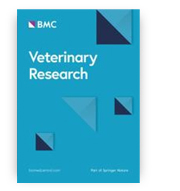Subcutaneous application of hyperimmune serum against Histophilus somni recombinant proteins affects serum antibody reactivity in beef calves
Joanna Bajzert; Paulina Jawor; Rafał Baran; Tadeusz Stefaniak
BMC Veterinary Research
Ministerial score = 140.0
Journal Impact Factor (2023) = 2.6 (Q1)
 Background Respiratory tract diseases cause significant economic loss in beef cattle. This study aimed to determine whether the application of hyperimmune serum (HS) containing antibodies against selected antigens of Gram-negative bacteria would improve the health and growth of different breeds of beef calves kept on three farms. Two recombinant protein antigens (Histophilus somni rHsp60 and rOMP40) were used to immunize four cows to produce HS. Eighty seven beef calves (Charolaise n = 36, Limousine n = 34, and crossbreed n = 17) were included into study. One hundred milliliters of serum were administered subcutaneously to 43 beef calves (Charolaise n = 18, Limousine n = 17, and crossbreed n = 8) twice, between 1 and 5 and 21–28 days of life. Calves were examined three times, and blood samples were taken to evaluate immunoglobulin M, G1, and G2, fibrinogen, serum amyloid A, and haptoglobin concentrations and reactivity of these Ig classes of antibodies against H. somni rHsp60 and rOMP40. Average daily weight gain during the first month and until weaning was calculated. Results HS showed higher (p ≤ 0.05) reactivity in calf sera against H. somni rHsp60 and OMP40 in IgG1 and IgG2. In experimental calves, compared to control calves, the reactivity of IgG1 against rOMP40 in the second sampling was higher in Limousine calves (p ≤ 0.001) and in the other two herds (p ≤ 0.05). Serum IgG2 antibody activity against H. somni rHsp60 in the second sampling was higher in experimental calves than in control calves in charolaise (p ≤ 0.05) and limousine (p ≤ 0.001) herds. The reactivity of IgG2 against rOMP40 in the second sampling of experimental calves was higher in herds with Charolaise and Limousine calves (p ≤ 0.001) and in crossbred calves (p ≤ 0.05). In the third sampling, serum IgG1 antibody reactivity against rOMP40 in Limousine calves was higher (p ≤ 0.05) in the experimental group. Among the other evaluated parameters, only SAA in the second sampling in the herd with Charolaise calves and heart rate in the herd with Limousine calves were significantly higher in the control calves (p ≤ 0.05). Conclusion The application of HS to calves in all herds had an impact on specific reactivity in IgG1 and IgG2 classes against H. somni rOMP40 and rHsp60, antigens which were used for serum production.
Background Respiratory tract diseases cause significant economic loss in beef cattle. This study aimed to determine whether the application of hyperimmune serum (HS) containing antibodies against selected antigens of Gram-negative bacteria would improve the health and growth of different breeds of beef calves kept on three farms. Two recombinant protein antigens (Histophilus somni rHsp60 and rOMP40) were used to immunize four cows to produce HS. Eighty seven beef calves (Charolaise n = 36, Limousine n = 34, and crossbreed n = 17) were included into study. One hundred milliliters of serum were administered subcutaneously to 43 beef calves (Charolaise n = 18, Limousine n = 17, and crossbreed n = 8) twice, between 1 and 5 and 21–28 days of life. Calves were examined three times, and blood samples were taken to evaluate immunoglobulin M, G1, and G2, fibrinogen, serum amyloid A, and haptoglobin concentrations and reactivity of these Ig classes of antibodies against H. somni rHsp60 and rOMP40. Average daily weight gain during the first month and until weaning was calculated. Results HS showed higher (p ≤ 0.05) reactivity in calf sera against H. somni rHsp60 and OMP40 in IgG1 and IgG2. In experimental calves, compared to control calves, the reactivity of IgG1 against rOMP40 in the second sampling was higher in Limousine calves (p ≤ 0.001) and in the other two herds (p ≤ 0.05). Serum IgG2 antibody activity against H. somni rHsp60 in the second sampling was higher in experimental calves than in control calves in charolaise (p ≤ 0.05) and limousine (p ≤ 0.001) herds. The reactivity of IgG2 against rOMP40 in the second sampling of experimental calves was higher in herds with Charolaise and Limousine calves (p ≤ 0.001) and in crossbred calves (p ≤ 0.05). In the third sampling, serum IgG1 antibody reactivity against rOMP40 in Limousine calves was higher (p ≤ 0.05) in the experimental group. Among the other evaluated parameters, only SAA in the second sampling in the herd with Charolaise calves and heart rate in the herd with Limousine calves were significantly higher in the control calves (p ≤ 0.05). Conclusion The application of HS to calves in all herds had an impact on specific reactivity in IgG1 and IgG2 classes against H. somni rOMP40 and rHsp60, antigens which were used for serum production.
DOI:10.1186/s12917-024-03895-2









